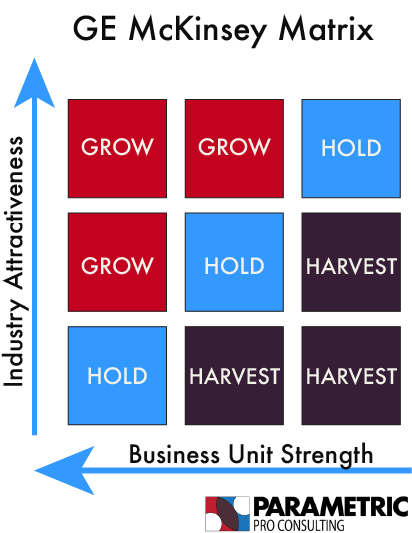The GE-McKinsey Nine-Box Matrix is a business strategy framework for helping business portfolio planning. This method helps businesses decide: where to invest their money, which units to be focusing their energy on, which units should they hold and which ones should they let go of. Essentially this tool offers a systematic approach for multi-business corporations to determine where to best invest their money. It is also used to evaluate the individual business units of these corporations.
The Matrix
The GE-McKinsey Matrix has a y-axis, representing industry attractiveness, and an x-axis revealing the strength of the business unit. The three degrees of the matrix (high, medium, and low) provide nine different strategic arrangements for a business.
Once the SPUs have been plotted on the matrix, then we can create investment strategies based on where each SPU appears in the matrix. Broadly speaking you’ve got three options available for each SPU.

The Y Axis - Industry Attractiveness
Industry attractiveness specifies how hard or easy it will be for a company to compete in the market and make profits. This means that the more profitable the industry is, the more attractive it becomes.
Because the investments needed for the product usually require long-lasting commitment, analysts look at how an industry will change in the long run rather than near future, when evaluating the industry attractiveness.
When determining the competition level of an industry, many factors are considered:
Size of industry
Pricing trends
Macro environmental factors (PESTLE framework)
Seasonality
Labour availability
Market segmentation
Changes in demand
Long-run growth rate
Profitability of industry (Porter's Five Forces framework), barriers to entry, barriers to exit, supplier power, buyer power, the threat of new entrants, and the threat of substitutes.
Product life cycle changes
The X-Axis - Competitive Strength of a Business Unit
The competitive strength of a business pinpoints how strong a particular business product or unit performs against its competitors. This involves determining whether the business has a sustainable competitive advantage or not.
The factors that determine the competitive strength of a business unit are as followed:
Total market share
Market share growth in comparison to rivals
Level of product differentiation
Production flexibility
Company profitability
Customer loyalty
Strength of a value chain
Strength of brand
Red - Grow
Invest in a business that falls in this position.
Blue - Hold
Possibly potential in the business, but it isn’t obvious. Investments should not be made until investments from the green SPUs have been made.
Purple - Harvest
Get rid of this business unit.
Understand that a business portfolio is a group of businesses that make up a company, and we call these individual businesses Strategic Business Units or SBUs.
Certain businesses can have many SBUs, yet no business has an infinite amount of forces or money it can invest.
The matrix allows a business to analyze its portfolio of SBUs to determine:
Which SBUs should receive more/less investment?
What new products or SBUs are needed in the portfolio?
Which products or SBUs should be divested?
Let's dive further into some examples of when you would either grow, hold or harvest your business unit. If you're in a high-growth industry, and the unit is strong, you will want to grow that unit and continue investing in it. Another instance where you want to grow your unit is when the industry attractiveness is average, but your business unit is strong. This works vice versa, when the industry is high, and your business unit strength is average it is still worth investing in to become more powerful. When everything is average, from the industry to the business unit, you will want to hold there. Another case where holding is the appropriate solution is when there is a high industry attractiveness but your business is weak in it. And lastly, if you have a low business unit and the industry attractiveness is average, get rid of it. This also applies if the industry attractiveness is low and your unit has average strength.
The GE- McKinsey matrix is a simple method, incorporating multiple factors, that will help you decide which business units to expand, hold and extract to maximize profits. For corporate strategists in portfolio management, the matrix works as a great starting point on which to base investment decisions.
If this article was helpful to you, please consider sharing it with your network!
For more useful information, check out our other Insights!
Are you interested in the consulting industry? Parametric Pro Consulting Foundations offers more in-depth knowledge on this article as well as several other topics to prepare you for a career in business and consulting. Check it out here!
